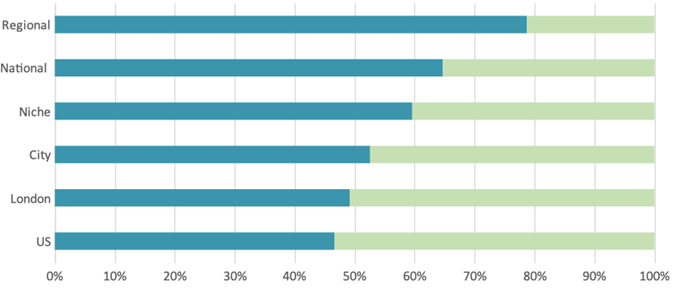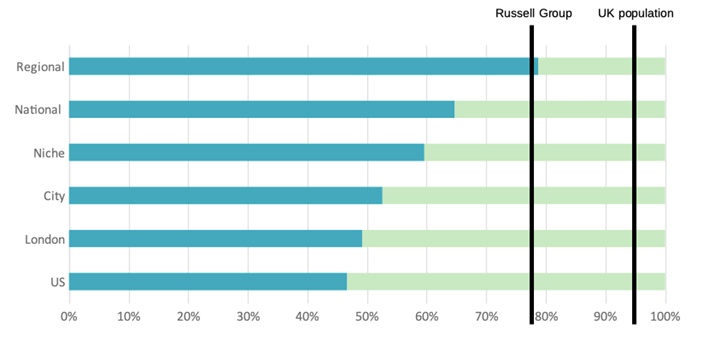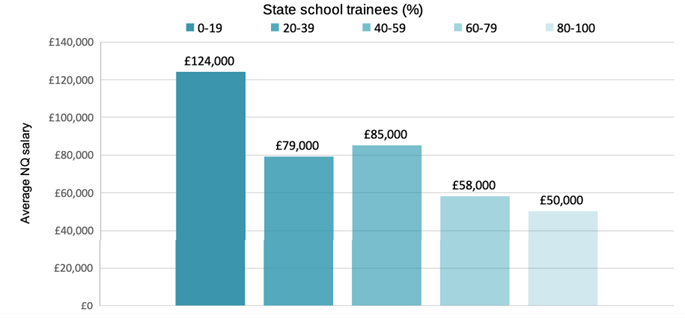
Read on for our 2020 analysis of the school backgrounds of trainee solicitors.
Rhia Lyon, February 2020
Along with info on gender, ethnic and LGBT diversity, we regularly ask the firms featured in Chambers Student to tell us which types of school their trainees went to (broken down into state, private or overseas education). We include a variety of types of firms in our research; small ones with just one office outside the City, big London players, US-headquartered firms, the magic circle and sprawling national outfits. For the purposes of this study, we’ve lumped the magics in with other City firms – only three of the five firms provided data, and none a complete set.
In this year’s analysis, we’ve gone further than before and separated the figures for country-spanning national firms and regional players; and treated niche firms with one distinctive practice as their own category. It should be noted that the 59 firms we analysed have vastly different trainee intake numbers – ranging from two to over 100 trainees – and that not all firms could give us the data for every single trainee.
State of the nation
Even with these limitations, a trend has emerged that we’ve not seen since starting these analyses – on average, the law firms we cover are recruiting more trainees from state schools than the private education system. The change is noticeable – in 2017 just 45% of trainees were state-educated, but in 2019 the figure climbed to 52%.
We’ve grouped private and overseas educational backgrounds together (green in the graph below), as with previous surveys. It’s clear that there’s huge variance across the legal industry – regional and national firms are leading the way, recruiting far more pupils from state schools (blue) than average.

That said, there’s significant movement in the lower end as well – for the first time, the City firms in our survey had more state than privately-educated trainees, and the proportion at US firms has jumped 15% (take this with a pinch of salt, however, as many American firms have very small intakes which can swing the figures dramatically with minor shifts). Figures at non-City London firms appear to have stagnated, as have the state-to-private proportions at multi-office national players.
It looks like things are moving in the right direction, but there’s still a big discrepancy between the legal industry and the UK as a whole. Add into the graph the dividing lines of state-to-private education across the country, and even across the elite Russell Group universities, and the differences are clear.

Show me the money
Two years ago, we found a direct correlation between school backgrounds and salary: the firms with the highest population of former state school paid the least, and firms which favoured independently-educated trainees paid the most. Not much has changed since then – the biggest shift heading into 2020 is that firms with the lowest proportions of state school graduates are racing ahead of the market on salary.

Compare this with last year’s results, and you’ll see how little has changed otherwise. As with 2017, there’s little difference in the 20-59% state school trainees bracket, nor at firms with more than 60% state schoolers. The real anomaly is the handful of firms which recruit more than 80% of trainees from private or overseas-educated backgrounds. This is reflective of broader market salary trends, with the top end soaring higher and higher above the average.
Class dismissed
What can we learn from this analysis, within wider context? We do know there are 2,300 fewer pupils in independent schools this year compared with 2017, even though the total number of pupils in all UK schools has been increasing year-on-year for the past decade. Proportionally, however, that’s a drop in the ocean given there are 8.8 million students in UK schools total.
The safest conclusions are the same as previous ones – there’s a market-wide bias towards privately educated candidates, which becomes more extreme at firms with higher salaries. Lots of factors might play a role in this – the perceived greater ‘polish’ that comes with a private education; implicit bias from recruiting lawyers who were themselves privately educated; or self-selection on the part of candidates themselves.
As in other areas of diversity, RARE contextual recruitment is helping to change the game. This software allows recruiters to view graduates' grades in the context of their educational background using factors such as whether the student received free school meals, whether they are the first in their family to go to university and the deprivation index of their school postcode. RARE suggest that firms adopting their methods hire 61% more people from disadvantaged backgrounds.
The legal profession isn’t going to change overnight, and we’d say that slow progress is better than no progress. Firms are coming under pressure from their clients to recruit young talent from more diverse sources, so we’ll hopefully see the numbers shift more and more in favour of candidates with a state school education.
Up next in our 2020 series, LGBT+ representation in the the law.